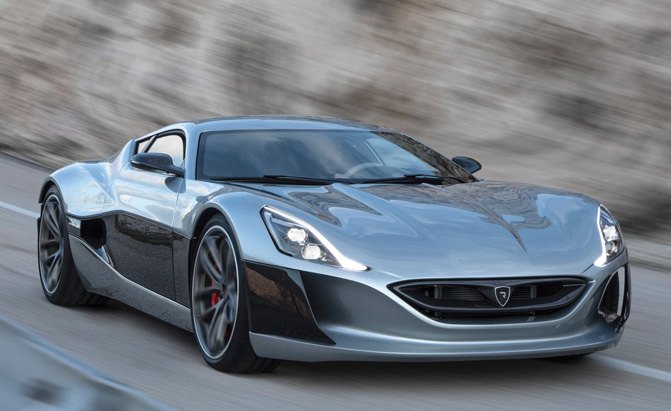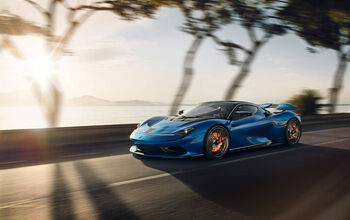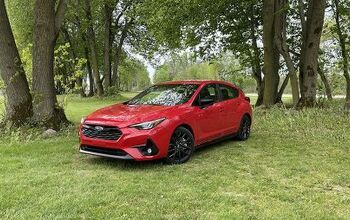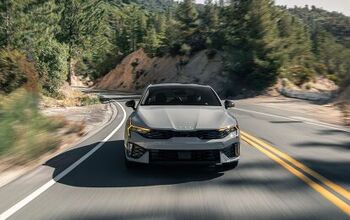Top 5 Electric Sports Car Alternatives to the Tesla Roadster

When the Tesla Roadster arrives in 2020, it could be one of, if not the fastest electric performance cars on offer. We say ‘one of’ because Tesla isn’t alone here – there are a few companies with some very exciting performance EVs in the pipeline.
Today, we’re going to offer up some electric performance alternatives to the Tesla Roadster for those who like to go fast but want a low-emission way to do it. Some of these are available today, whereas others should be on the market by the time the new Tesla Roadster arrives. They may not offer up the same insane specs the Tesla does, but each are impressive in their own, unique ways.
5. Porsche Mission E
The Mission E is often touted as the strongest potential competitor for Tesla’s array of high-performance electric product. It’s not in showrooms yet, but prototypes have been spotted testing putting in laps at the punishing, 12.9-mile Nurburgring Nordschleife. Rumors point to Porsche offering 402, 536, and 670 hp versions of the performance EV. We also hear a 936 hp version will be available with two 375 hp electric motors out back and a 186 hp motor out front. That should do the trick.
4. Ariel Hipercar
This is another one that’s yet to reach production, but there’s plenty of reason to be confident in its capabilities. The ‘Hipercar’ is the work of the track-day masterminds over at Britain’s Ariel and is being built with the support of the UK government. The company says it will be powered by four separate 295 hp electric motors, which will be fed by a 56 kWh battery pack. It will have a rather impressive EV range of around 100 to 120-miles, but it will also come with a gas-turbine range extender. It has 1,180 hp on tap and 1,328 lb-ft of torque, enabling 0-60 mph sprints of just 2.4s. Look for it to arrive in 2019.
3. Rimac Concept One
The Rimac Concept One is now infamous after The Grand Tour’s Richard Hammond had quite the nasty accident in one earlier this year. The brainchild of 28-year old engineer Mate Rimac, the EV hypercar makes 1,224 hp and 1,180 lb-ft of torque. It can also nudge 220 mph and travel over 200 miles on a single charge thanks to its 92 kWh battery. Rimac made just 8 of them, and they’ve all been sold. We reached out to a distributor for Rimac, who told us “the car is sold out from the manufacturer’s side, but the US dealer (Manhattan Motorcars) might have a car available.” Rimac also have a new car coming that has been in development for a few years and will be sold through a US dealer network consisting of 6 storefronts.
SEE ALSO: Watch the new Tesla Roadster Accelerate and Go Into Plaid
2. Genovation GXE
We know – it looks like we’re trying to pass the C7 Corvette off as an EV. We’re not! This is actually the C7 Z06-based Genovation GXE, the production version of which debuted at the SEMA Show earlier this year. It will feature a 44 kWh battery pack and a single electric motor making 660 hp and 600 lb-ft of torque. The company claims it will do the 0-60 mph dance in less than three seconds and a prototype for the car set a record EVs by hitting 209 mph. Genovation will build 75 of them, and if you have $750,000 handy, you can have one right now. Just visit its website.
1. Nio EP9
The Nio EP9 might be our favorite performance EV to date. It not only looks like a road-going Le Mans prototype (both inside and out) but it has the performance of one too. With four motors making 1,341 horsepower and a ridiculous 4,671 lb-ft of torque, the EP9 lapped the Nurburgring in a stupidly fast 6:45.90 – though it’s worth noting it did that on slick tires. It will also accelerate from 0-60 mph in 2.6s and top out at around 195 mph. Nio sold six of the cars to investors for $1.2 million each and will build another 10 for the general public. If we had the cash, we’d be begging Nio to take it off our hands and build us an EP9.
Discuss this story on our hybrid cars forum.

Sam McEachern holds a diploma in journalism from St. Clair College in Windsor, Ontario, and has been covering the automotive industry for over 5 years. He conducts reviews and writes AutoGuide's news content. He's a die-hard motorsports fan with a passion for performance cars of all sorts.
More by Sam McEachern





































Comments
Join the conversation
Whoever handles Elon Musks public relations deserves a medal. The slippery snake oil salesman and rent-seeker extraordinaire has been down to South Australia now reduced, pretty much, to a third world state under its disastrous left-wing administration and conned the hapless locals out of $50 million to build them an all-but-useless giant battery to make up for the energy they have lost by blowing up their coal-fired power station and relying on wind power instead. And how are the lickspittle media reporting this outrageous scam? Tesla Fulfilled Its 100-Day Australia Battery Bet. Whats That Mean for the Industry? Elon Musk wins bet, finishing massive battery installation in 100 days Incredible $50 MILLION bet between Elon Musk and Australian Atlassian tech king pays off with Tesla building a giant solar battery in Adelaide With a media as compliant and unquestioning as this, is it any wonder Teslas price is still about $300 higher than it should be and that governments continue to spend taxpayers billions bankrolling his quixotic schemes? Lets just have a quick reality check here, shall we? Obvious Truth #1. This bet is #fakenews. A bet is where you risk a sum of money on a chance event on whose outcome you are uncertain. Musk knew perfectly well he was going to get his giant battery plant finished in time. Otherwise he wouldnt have made his bet. Musk did not get to be worth nearly $20 billion taking $50 million gambles even if it is true that when youre as rich as him $50 million counts as small change. No, he got rich at least in part thanks to his remarkable ability to talk the hind legs off a donkey. In this case, he persuaded pretty much the entirety of the worlds media that when a businessman makes a deal in which a project has to be completed within a certain time frame this isnt called fulfilling your most basic job requirements but winning an incredible bet. Obvious Truth #2. South Australia needs Elon Musk and his giant battery like it needs a Taipan in the dunny. Thats because, as Paul Homewood has been impolite enough to notice, the battery will make next to no difference to South Australias massive energy problem. South Australia, youll recall, has been experiencing the kind of black outs and brown outs youd never imagine could be possible in a first world economy in the early 21st century. These have been caused entirely by its left-wing governments obsession with green energy. Will Musks giant battery actually not one giant battery but a bank of lots of smaller batteries supply the shortfall? Nope. Homewood does the math: The battery is rated at 129 MWh. Currently generation in South Australia is running at 1878 MW, so the Tesla battery could only run the grid for 4 minutes. Alternatively, according to Tesla, it could power 2500 homes for a whole day, or 15000 for four hours. Given that there are 673,000 households in South Australia, the Tesla battery is an expensive irrelevance. Australia, by the way, is a large island consisting underground of almost nothing but fossil fuels and other useful mineral deposits. The idea that it should be powering itself using bat-chomping, bird-slicing eco-crucifixes and then trying to store some of their excess power in lithium batteries quite defies belief. Here, again courtesy of Paul Homewood, is the chart that puts this lunacy into perspective: Theres coal, still providing 73 percent of Australias electricity, with gas providing another 14 percent. Wind power, meanwhile, provides just 3 percent. So if youre Australian and you drive a Tesla theres something you ought to know: youre driving a mostly coal-powered vehicle.
God! I do love beautiful things!